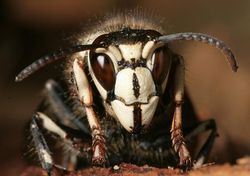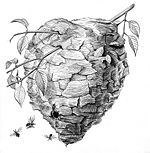Bald-faced hornet
| Bald-faced hornet |
|---|

|
| Scientific Classification |
|
| Binomial Name |
|
Dolichovespula maculata |
The Bald-faced hornet is a species of yellow jacket (not a true hornet) known by the scientific name Dolichovespula maculata. It is found throughout North America. It is also known as white-faced hornet and the bald-faced yellow jacket. They are 5/8 to 3/4 inch long and are commonly confused with honey bees, solitary bees, ground- and house-nesting yellow jackets, and hornets. The Aerial-nesting yellow jacket is the most alike the Bald face hornet, but it has different characteristics. Aerial-nesting yellow jacket is smaller than the bald-faced hornet and a hairless body the abdomen is black with yellow stripes and markings. The Bald-faced hornet is distinguished by their black and white patterns on face, thorax, abdomen, and first antenna segment and are mostly hairless.[1]
Life Cycle
One of the most interactive insects are the Bald-Faced hornet. Up to 400 workers can be in the nest.The queen makes her golf-sized nest with chewed wood pulp.Nests are typically located about 10 to 12 feet high in tree or shrub branches The outside of the nest is made of a papery casing with a ventral opening.More paper is added to the nest as more hornets are added to the colony.[2]The queens sole job during this time is to lay her eggs.Eggs are laid in separate cells by the queen.Larvae begin life out of the egg without legs and go through a number of stages before they reach adulthood.Workers feed Larvae chewed up insects.While larvae is developing, the top of the cell where eggs are kept is left open.[3] Workers seal the cells after they reach adulthood. Before beginning a new colony in the spring,the hornets die all except the queens who hibernate underground, in cracks or in a place safe from predators in the winter. while the queen restricts herself to laying eggs[4].
Ecology
Hornets nests are aerial, meaning "high", they're usually found in trees and sometimes on the side of buildings.Sugary substances from flowers are given to the larva from the adults. Along with sugary substances, larvae are fed insects that get trapped in the nest. It is not just a one way street of the workers feeding the larvae, Larvae also feed the adults a sweetish secretion from their mouths.
Management
To warn people of a hornets nest in the trees, signs can be put up if there is low population in that area.It is not the same for high population areas as they are more dangerous and should be treated.Bald-faced hornets live high in trees or shrubs so should not be killed unless they pose a risk. To control the hornet infestation spray an insecticide right in the ventral opening If control is necessary.To fully be successful, this process may need to be performed a number of times.In the evening is the best time to perform this because the hornets are in their nest.To help reduce the possibility of getting stung, make sure to cover as much skin as possible.Create a way to get out of the situation if worst comes to worst. To fully be successful, this process may need to be performed a number of times. Hornets are attracted to light and smell so do not spray perfume or use unnecessary lights. Hornets are blind to red lights so if required, use a red colored paper to cover the light.If you don't wanna take the risk of being stung, the best option is calling a professional such as pest control[5]
Sting
Stings of any kind of bee can be painful. If you are stung, numb the wound with ice. Bald-faced hornets are protective and unlike bees who have been known to sting only once, will sting numerous times if their nest is disturbed.Contrary to belief, hornets normally don't sting outside of the nest. Hornets have a more potent sting then bee's.Being non-life threatening, it is not required to go to the doctor or emergency room unless you have an allergic reaction, There are a lot of symptoms of a reaction to a sting.[6]
References
- Bald-faced hornet. Wikipedia. Web. 11 November 2011. unknown author.
- Drees, B.M. and John, Jackman. Field Guide to Texas Insects. Houston, Texas: Gulf Publishing Company, 1999
- Gardner, K., Klass, C., and Calderone, N. Stinging Insects: Bald-Faced Hornets and Aerial-Nesting Yellow Jackets. Dyce Laboratory for Honey Bee Studies. Web. July 2004.

